Top Tier CPU Air Coolers Q3 2015: 9-Way Roundup Review
by E. Fylladitakis on July 6, 2015 8:00 AM ESTThe Phanteks PH-TC14PE
Phanteks is another world-renowned CPU cooler manufacturer, whose high performance designs made them widely known very quickly. Aside from coolers and fans, the company is now active in the field of PC cases as well. For the means of this review, Phanteks supplied us with the PH-TC14PE, their largest and most popular CPU cooler. The PH-TC14PE actually is over two years old, making it the oldest design in this roundup review.
Phanteks supplies the PH-TC14PE in a large cardboard box with an abstract design showcasing the color variations of the cooler. Inside the box, the cooler is well protected within a polyethylene foam shell and the bundled items are secured in small boxes. Aside from the hardware necessary for the mounting of the cooler, Phanteks also provides a tube of quality thermal grease, six anti-vibration rubber strips for the fans, a fan power cable splitter, a fan speed reducer. They also provide six wire clips and twelve plastic fan clip adaptors, for the installation of up to three fans onto the cooler's body.
The PH-TC14PE is a very large symmetric dual tower cooler. The fronts of the fins form small circular notches, with the exception of the top fin that is straight and serves as a cover for the heatpipes as well. One of its prominent features is instantly apparent, which is the colored fins. There are five color variations of the PH-TC14PE and we received the black version. Phanteks calls this "Physical Antioxidant Thermal Shield" (or Physical Antioxidant Thermal Spraying - we found both in the company's texts) and claims that it enhances thermal performance by both increasing the dissipation rate of the heatsink itself and decreasing the radiation absorption rate from other heat sources. The fins are soldered on the heatpipes with another patented method that Phanteks calls "Cold Plasma Spraying Coating", which supposedly increases the heat transfer rate between the copper heatpipes and the aluminum fins.
Phanteks provides two of their own PH-F140 140 mm fans with the PH-TC14PE. The company loves abbreviations, so the PH-F140 have "Updraft Floating Balance (U.F.B)" bearings, "Maelstrom Vortex Booster (M.V.B)" blades and "Maelstrom Air-Fort Optimization (M.A.F.O)" drive systems. Other than the fancy names, no real technical data or schematics of these technologies can be found. All we are left with is their standard manufacturer specifications, which indicate a maximum speed rating of 1300 RPM (1200 RPM in PWM mode). The design of the wire clips allows the fans to be moved upwards by several centimeters, providing clearance to RAM modules and heatsinks that would otherwise be blocked, assuming that the case is wide enough of course.
The base of the PH-TC14PE is simplistic, virtually meant only to provide mechanical retention for the installation on a CPU. Five thick 8 mm heatpipes run through the base and to both fin arrays on either side. The copper bottom half of the base and the heatpipes are nickel-plated, with the contact surface polished fairly well but not down to a perfect mirror finish. Slight machine marks can be seen on the contact surface but there are no major imperfections to speak of.


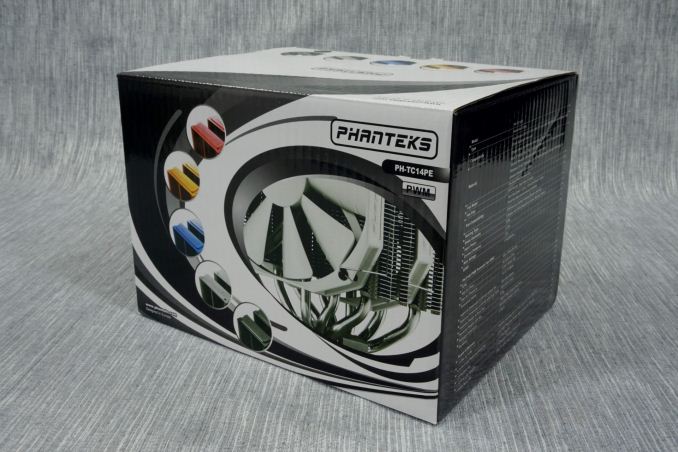
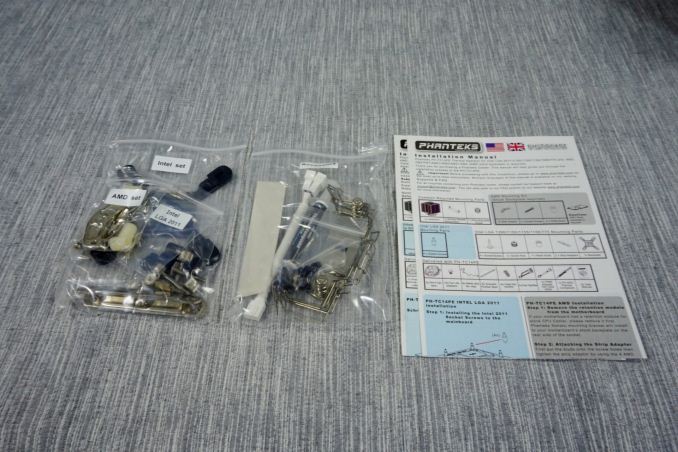
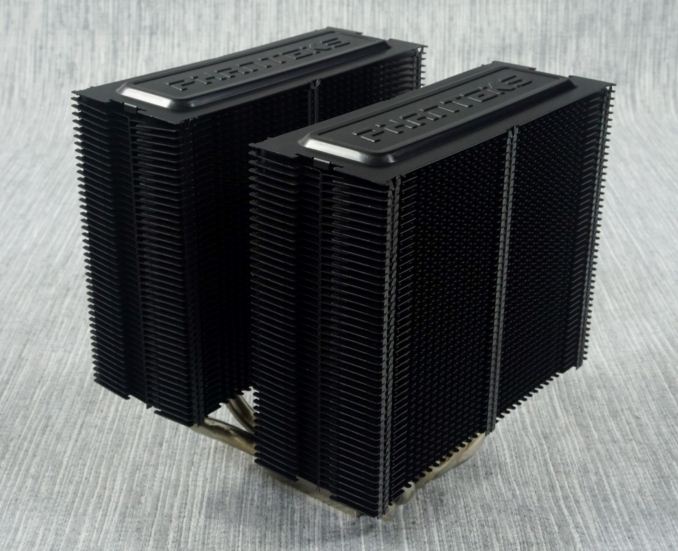
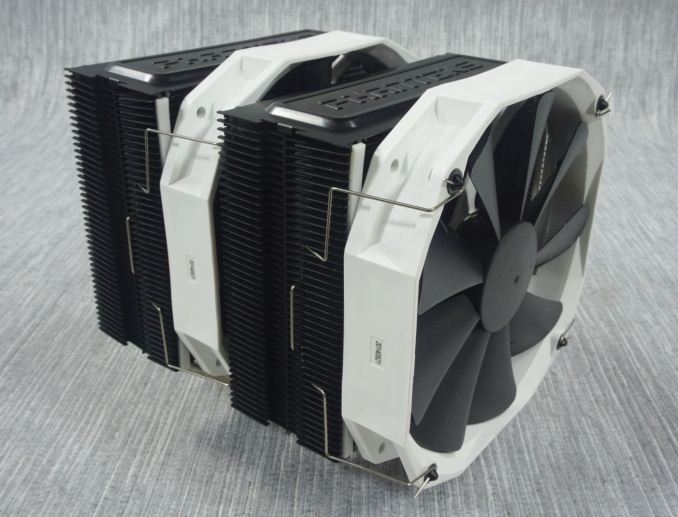
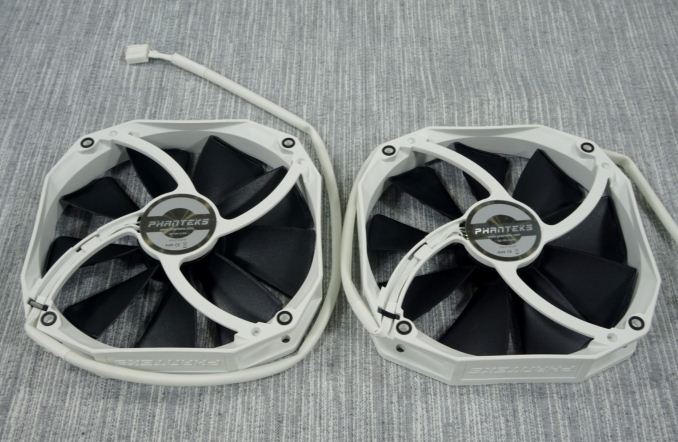
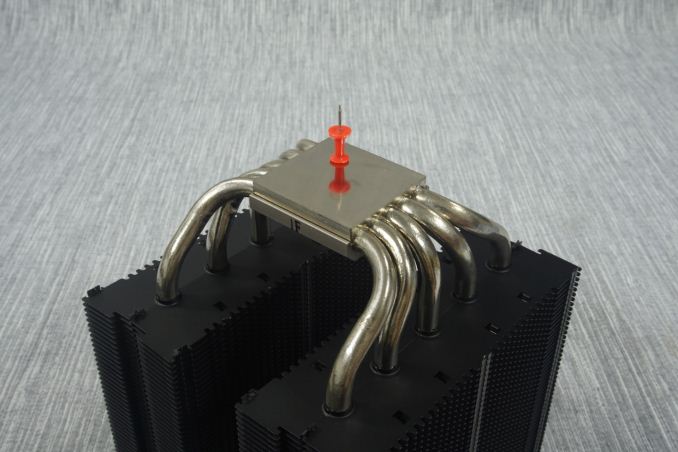








135 Comments
View All Comments
MartenKL - Monday, July 6, 2015 - link
I would of course like to see the testbed updated to have fan/s controlled by thermals, ie something like ASUS Fan Expert. Set for a target temperature and loads in the more realistic range of 15-150 watts. And of course when reducing voltage it should be via PWM and not simply reducing static voltage. The results should then be presented in temperature variance and noise levels/profile.MrSpadge - Monday, July 6, 2015 - link
Good suggestions. I hate those charts with "full fan voltage" and "fan voltage reduced to ..". What I really care about is "how silent can the cooler be for a given temperature / cooling performance?" And "which one cools better at similar noise level".It doesn't help much to see a strong fan with inbearable noise in those charts. Even if someone is interested in such solutions - wouldn't his question rather be "which heatsink performs best with this high-speed fan"? Which would again be something he couldn't answer from this data.
I know making noise based comparisons is difficult. But the raw sound pressure could be accompanied by some subjective remarks regarding the noise spectrum.
Cookiespy - Monday, July 6, 2015 - link
It would be interesting to see how the stock coolers compare to this high performance cooler. I wouldn't pay $80-100 just to see 5degrees improvement.Eidigean - Monday, July 6, 2015 - link
Chips big enough to need these coolers, such as Socket 2011, do not come with stock coolers.meacupla - Monday, July 6, 2015 - link
The stock heatsink cools great and is pretty silent with stock settings in a case with decent airflow, end of story.These kinds of $80 heatsinks are what you want when you overclock, but with the same or lower noise levels.
If you don't overclock, then a $20~25 heatsink can do a 5~20C improvement and keep the computer quieter at the same time too.
Eidigean - Monday, July 6, 2015 - link
What are you, a shill for Intel? The Intel stock heatsinks are the absolute worst. Check out the graphs from this Anandtech article:http://www.anandtech.com/show/6830/cpu-air-cooler-...
Dead last in performance AND noise. Stock heatsink was greater than 30 degrees C hotter, and 20 decibels louder.
meacupla - Monday, July 6, 2015 - link
It says right there in the system specs used to test those coolers..."Intel Core i7-2700K overclocked to 4.4GHz @ 1.4V"
I'm surprised the stock intel heatsink was able to complete the tests.
meacupla - Monday, July 6, 2015 - link
no wait, look, it says the stock heatsink and a low profile heatsink failed on an overclocked i7.Like I said, stock intel heatsink, especially the one with a copper core, works great at stock speeds.
Azurael - Friday, July 17, 2015 - link
I don't know if the stock HSFs have changed since Sandy Bridge, but my 2500k would hit 98+ degrees and throttle under AVX loads with the pathetic little stock thing whilst sounding like a small tornado had developed inside my case (how is it that a 95w CPU comes with an HSF half the size of the ones they used to ship with 65w C2Ds?!)Whichever cheap tower cooler I replaced it with does the job just fine, though. It's been running like a champ at 4.5GHz for near enough 4 years now. (I think it's a Xigmatek SD1283 - I haven't even taken the side off my machine for over a year, those heady days of tinkering and yearly upgrades long since passed.)
bug77 - Monday, July 6, 2015 - link
What, no mention of the weight of each cooler? I think that's a rather important aspect.